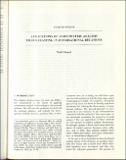| dc.description.abstract | This chapter examines some key issues and difficulties encountered in the course of applying econometric analysis to forecasting in international relations. We will note the problems involved and the solutions adopted, and indicate the conse- quences of faulty analysis, analytical bias, or measurement error. ln so doing, we shall draw upon our recent investigations into the long-range causes of international conflict. Our objective, during the past several years, has been to develop systematic procedures for isolating the determinants of international violence. The general approach we have employed is one common to any econometrician concerned with the analysis of time series data, or any statistician examining the properties of small samples. But our applications of these methods are not common to political analysis. Economists, for example, appear to know much more about the nature of market systems, business cycles, inflation, and so forth, than political analysts know about conflict and warfare, arms races, lateral pressure, or international alignments. | en_US |
| dc.identifier.citation | Choucri, N. (1978). Applications of econometric analysis to forecasting in international relations. In N. Choucri, & T. W. Robinson (Eds.), Forecasting in international relations: Theory, methods, problems, prospects (pp. – ). W.H. Freeman. | en_US |
